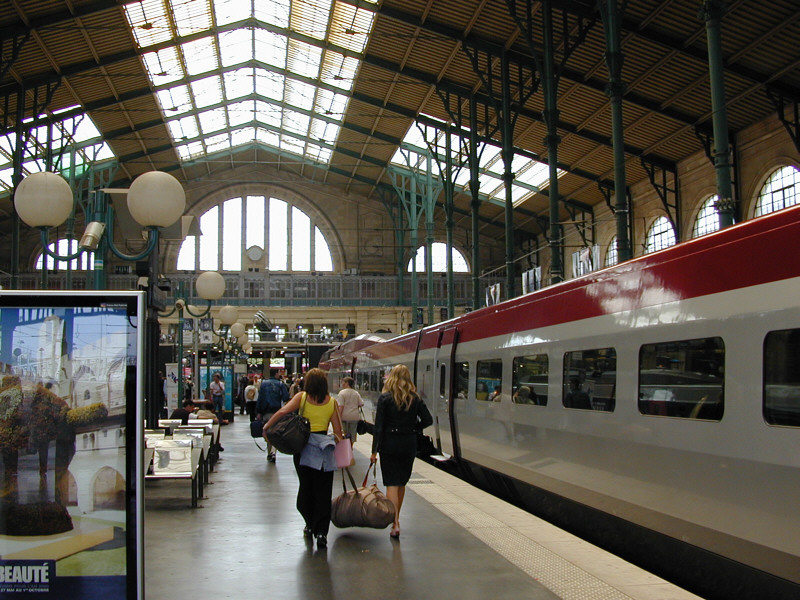
Railroading, European style
What do you think?
If American railroad stations looked like this, would we ride a train more often?
Or...if Americans rode a train more often, would our railroad stations look like this?
This is a classic example of Chicken vs. Egg!

Thalys, Gare du Nord, Paris
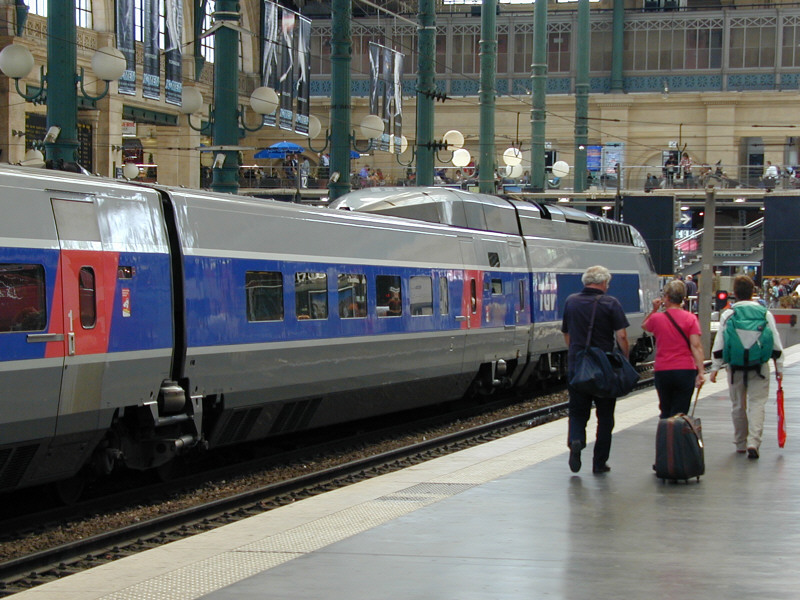
TGV, Gare du Nord, Paris
ICE at Stuttgart Hauptbahnhof Click for a close-up view
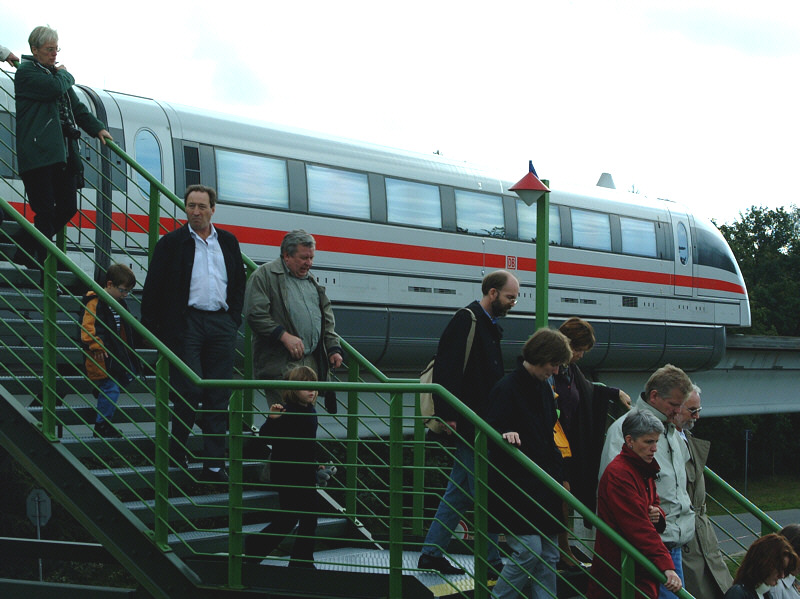

The Train of the Future?
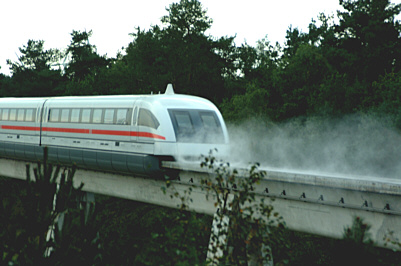
![]() The TransRapid doesn't ride on wheels, it glides without friction floating on a magnetic cushion about 20m
above ground. Magnetic fields not only lift the train, they propel it to
incredible speeds. Most impressive is the
peaceful quiet of the cabin, traveling at turbo-prop airplane speeds.
The TransRapid doesn't ride on wheels, it glides without friction floating on a magnetic cushion about 20m
above ground. Magnetic fields not only lift the train, they propel it to
incredible speeds. Most impressive is the
peaceful quiet of the cabin, traveling at turbo-prop airplane speeds.
This photo shows it coming out of a turn. During my ride, we were told the target speed coming out of this curve is 300 kph. Then TransRapid accelerates to 400 kph - "Cruising Speed" for this unique machine. It was a rainy day, which added to the impression of effortless speed.
This great project may fall aside. It's
expensive and the German government is afraid it will be highly subsidized.
Maybe we could buy a few in California for the SF/Sacto/LA traffic?
Amsterdam Centraal Station - Walk out into
the wonderland of Amsterdam Centrum
This station is so beautiful that I spent about 5 hours editing out poles,
wires and signs using other photos.
The gentleman in the lower center seems to be wondering why I would do such a
thing!
If you'd like to see the original, Click
Here
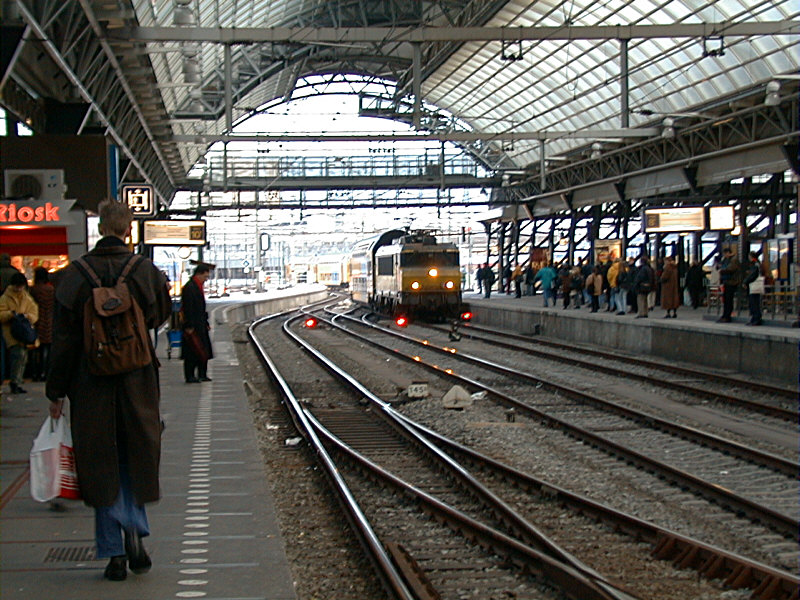
Amsterdam Centraal Station, Spoor
10b - Sneltrein naar Weesp, Narden-Bussum,
Hilversum en Amersfoort
Nice track arrangement! The throat into Amsterdam Centraal from Weesp serves 15
tracks within the station.
Each has an A and B half. A long train will use both ends,
while two short commuter trains use A and B.
Crossovers allow arrivals and departures from both A and B while they are
occupied - note the center track above.
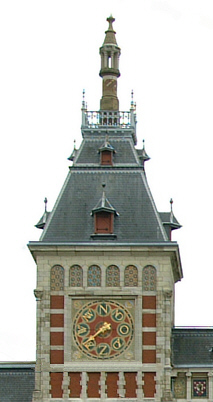 Amsterdam
Centraal is so busy it defies description. A train arrives or departs about once
every 60-90 seconds. Passengers flow out of the train doors and down the
stairs - newbies move along with the pack with wide eyes that are a give-away. People from all over the world
stream down three underground halls to the main station area, and like the
Space Odyssey voyage turned real, you're catapulted into the heart of
Amsterdam.
Amsterdam
Centraal is so busy it defies description. A train arrives or departs about once
every 60-90 seconds. Passengers flow out of the train doors and down the
stairs - newbies move along with the pack with wide eyes that are a give-away. People from all over the world
stream down three underground halls to the main station area, and like the
Space Odyssey voyage turned real, you're catapulted into the heart of
Amsterdam.
Except on rare occasions when things go wrong, departures reliably leave within 10 seconds of scheduled time. This Sneltrain ("Fast train" - faster speeds and fewer stops), departs from 10B at xx:10 and xx:40 every hour. It stops about 700 meters from my hotel - a 6 minute walk (or sometimes a 2:10 minute run). The trains are fully electric and I can't hear them more than 200m from the track.
Holland. Most Americans call it Holland, but to the Dutch its name is Nederland ("Low land") and we officially call it "The Netherlands". I have no idea why Americans say this - "Netherland" is the most common way the friends I've met refer to their country when speaking English. However, there definitely is a Holland! It is - well, a "state" - of Nederland. There is a North Holland and a South Holland. Amsterdam, Het Gooi (an affiliation of cities and towns), and my "home away from home" Hilversum are all in North Holland. Utrecht, home of the prestigious University of Utrecht, is about 10km south of Hilversum, and it's in South Holland. It's no wonder Americans say "Holland".
Did you notice the picture of the tower? Things like this keep me smiling when I'm in Holland. I'll bet you thought it was a clock tower, but look again. "Noord", "Zuid", "Oost", en "West". It's a wind vane prominently visible on Amsterdam Centraal's primary tower, and it's quite accurate. That's important here! The Dutch invented windmills for a very good reason: Wind is to Holland, as sun is to Las Vegas.
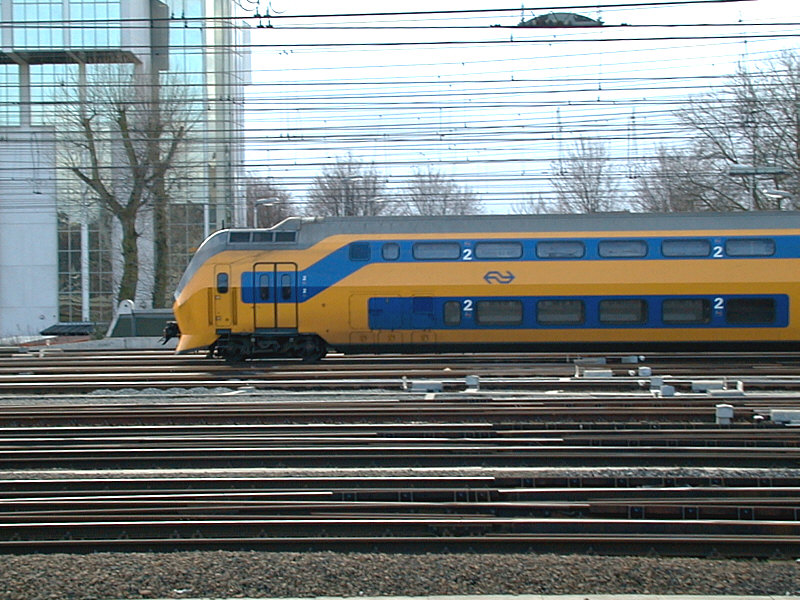
A double-deck commuter train arriving at
Utrecht. This is my favorite style of Dutch train.
They are extremely quiet and smooth, and the view from the top is great! Top
speed - about 140 kph.
Consider this: a friend works with the firm Arcadis. He designs track, sidings, tunnels and bridges for Nederlandse Spoorwagen, the Dutch State Railroad. One of his colleauges is designing a turnout that can route a train off the main line at 140 kph! If I recall correctly, it is a #48 turnout, but it may be a #60. Its frog moves with its points to maintain the precise geometry required for this task. 140 kph - that is 87.5 mph, taking the diverging route through a turnout! Some people work in a different world than we do!